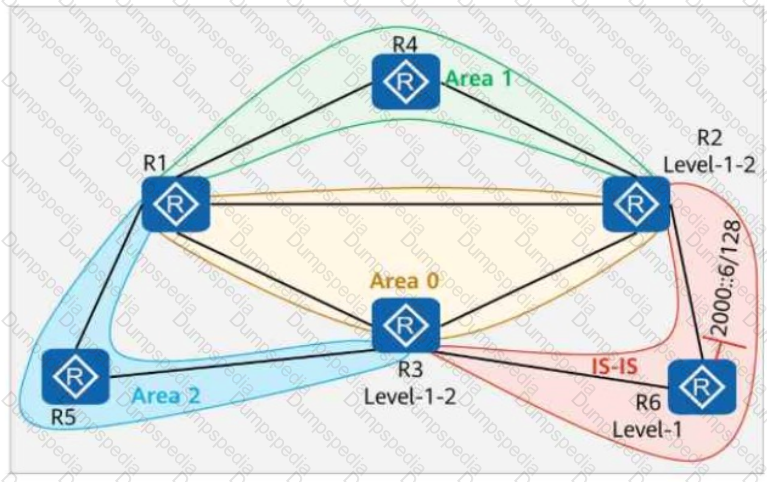On the OSPF network shown in the figure, drag the values on the left to the correct positions so that:
Traffic from PC1 to PC2 follows the path:PC1 -> R1 -> R3 -> R2 -> PC2
Traffic from PC2 to PC1 follows the path:PC2 -> R2 -> R1 -> PC1
Which of the following OSPF cost values should be assigned to Cost-A, Cost-B, and Cost-C to achieve this routing behavior?

On the network shown in the figure, a network engineer finds that the path between PC1 and PC2 is not the optimal path, and all links along the path have the same cost.
Given this, which of the following routers may be the root bridges of the Layer 2 network?

Options:
On the IS-IS IPv6 network shown in the figure, multi-topology is enabled on all routers.
The ipv6 default-route-advertise always level-1 command is configured in the IS-IS process of R4.
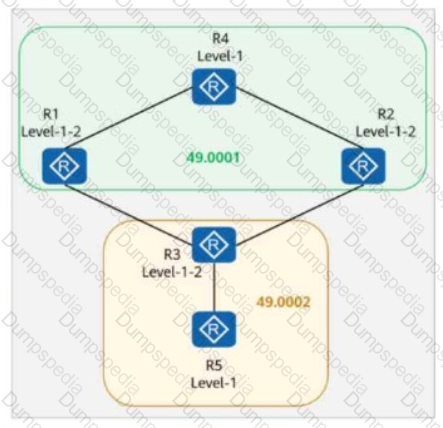
Which of the following routers does not have the default route in its routing table?
On the OSPFv3 network shown in the figure:
Area 1 is a stub area, Area 2 is a common area, and Area 3 is an NSSA (Not-So-Stubby Area).
The IPv6 address of Loopback0 on R6 is 2000::6/128.
The router ID of each router is 10.0.X.X, where X is the router number.
The stub no-summary command is configured in Area 1 on R2.
Which of the following statements is true?
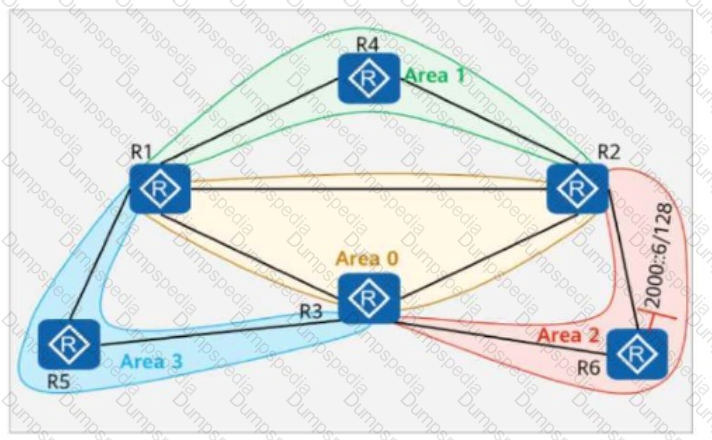
On the OSPFv3 network shown in the figure, the LSDB (Link-State Database) of R2 contains ______ Router-LSAs. (Enter only digits.)

On the network shown in the figure, EBGP peer relationships are established between neighboring routers through directly connected interfaces. The router ID of each router is 10.0.X.X, and the AS number is 6500X, where X is the number of the router. Both Rl and R4 have static routes to 192.168.1.0/24, which are imported to BGP through the import-route command. R3 is configured with the peer y.y.y.y as-path-filter 1 import command for all peers. Which of the following sets of commands enables R3 to select the route with the longest AS_Path to 192.168.1.0/24?
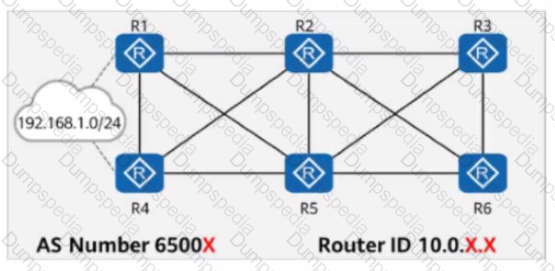
A network engineer obtains a multicast data frame whose destination MAC address is 01-00-5e-00-01-01. Given this, which of the following cannot be the destination IPv4 address of this frame?
Options:
Service routes of an enterprise are transmitted on the network. Some configurations of PE1 and PE2 are shown in the figure. Which of the following LSAs may CE2 receive?

The figure shows an MPLS packet with multiple labels.

Which of the following values for the S field is correct?
On the OSPF network shown in the figure, R1 and R2 are connected through four links. OSPF is enabled on Loopback0 of R2, and the maximum load-balancing 1 command is run in the OSPF process of R1. Which of the following is the outbound interface from R1 to Loopback0 of R2?
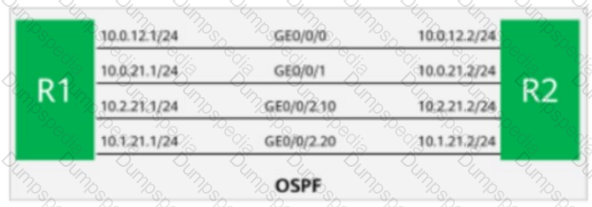
On a PIM-SM multicast network, a network engineer finds that multicast clients cannot receive multicast data. Which of the following is not a possible cause of this problem?
On the IS-IS network shown in the figure, R1 imports a default route using the default-route-advertise always level-1 command. Which of the following statements is false?

OSPF requires that routers in the same area have the same link state database (LSDB). As the number of routes on the network increases, some routers cannot carry so much routing information due to limited system resources. This state is called database overflow. If the Isdb-overflow-limit number 7 command is run on all routers on an OSPF network, which of the following conditions are likely to cause routers to enter the overflow state?
On the OSPFv3 network shown in the figure, OSPFv3 is enabled on the interfaces connecting R1, R2, and R3. The router ID of each router is 10.0.X.X, where X is the number of the router.
If you check detailed information about an LSA on R3, the command output shows that R1 and R2 are DRs on the network.
Options:
On the network shown in the figure, single-hop BFD is configured on R1 and R2.
A network engineer finds that the BFD session goes down. To locate the fault, the network engineer queries the BFD configurations on R1 and R2.
According to the configuration information marked in the figure, it can be determined that mismatched time parameter settings on R1 and R2 cause the BFD session to go down.

Is this statement TRUE or FALSE?
On the OSPFv3 network shown in the figure, area 1 is a stub area.

Which of the following LSAs is generated by only one router?
OSPFv3 packets are encapsulated in IPv6 packets. Which of the following is the value of the Next Header field in the IPv6 packet header?
Options:
During an attempt to log in to a NetEngine AR6120 through the console port, the network engineer finds that the password is incorrect and the login fails. If a Telnet account can be used to log in to the device and the account has the permission to change the console port password, the network engineer can log in to the device through Telnet to change the console port password.
When configuring port security on a switch, the administrator also enables static MAC address flapping detection. If static MAC address flapping occurs, the switch takes the configured action to protect the interface.
Match the names of interface security protection actions with corresponding operations.

If the display ospfv3 peer verbose command is run to check OSPFv3 neighbor information, the command output contains information such as the peer router ID, global unicast address of the peer interface, and neighbor status.
On the OSPF network shown in the figure:
Area 1 is a common area.
Area 2 is a totally NSSA (Not-So-Stubby Area).
Area 3 is an NSSA.
R5 imports the external route 10.0.5.5/32 into OSPF.
Which of the following routers have the route 10.0.5.5/32 in their routing tables?
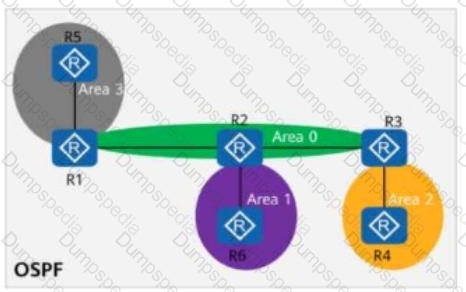
On the OSPF network shown in the figure, area 1 is an NSSA, area 2 is a common area, and R4 imports an external route 10.0.4.4/32. The router ID of each router is 10.0.X.X, where X is the router number. If the asbr-summary 10.0.4.0 255.255.255.0 command is run in the OSPF processes of R1 and R3, which of the following routers have the route 10.0.4.0/24 in their routing tables?
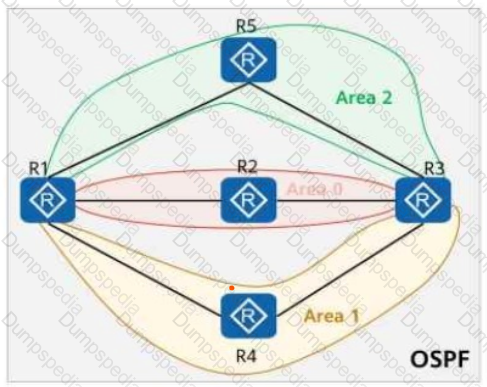
On the network shown in the figure, PC1 and PC2 are connected to the same switch (SW1) and belong to the same VLAN.

Which of the following are possible causes of a communication failure between PC1 and PC2?
Options:
In the hub-spoke networking shown in the figure, to ensure correct route transmission, an administrator must manually configure the peer 10.1.2.1 _____ command in the IPv4 address family view of the BGP-VPN_out instance on the Hub-PE.

(Enter the answer in lowercase letters only.)
In the figure, packets are forwarded based on MPLS on the network.
When PE2 receives a packet from P2, what is the label value carried in the packet?

Options:
The figure shows information about VPN1 on a PE (Provider Edge) router in a BGP/MPLS IP VPN network.
When the VPNv4 route corresponding to VPN1 is advertised to the remote PE, which VPNs of the remote PE will accept the route?
VPN1 Configuration:
ip vpn-instance VPN1
ipv4-family
route-distinguisher 100:1
vpn-target 100:1 200:1 300:1 export-extcommunity
VPN Import Policies on the Remote PE:
On the OSPF network shown in the figure, the cost values of links are marked. IS-IS Auto FRR is enabled on R1. The primary path from R1 to 10.0.3.3/32 is R1 → R2 → R3, and the backup path is R1 → R4 → R2 → R3.
Is this statement TRUE or FALSE?
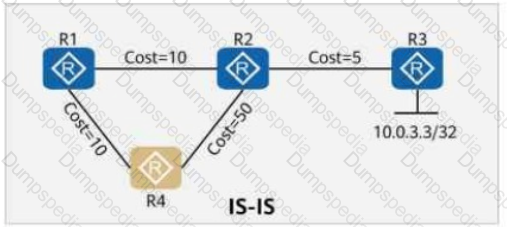
In CE multi-homing scenarios, if BGP AS number substitution is enabled on PEs, you can run the peer soo command on the EBGP peers of the PEs and CE to configure the Site of Origin (SoO) attribute to prevent loops.
On the ISIS network shown in the figure, R1 imports a default route using the default-route-advertise always level-1 command. In this case, R3 can learn this default route through IS-IS.
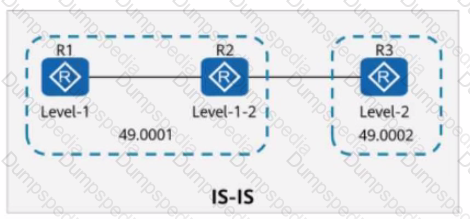
If the migration preparation is insufficient, which of the following problems may occur?
Options (Multiple Choice):
On the OSPF network shown in the figure, area 1 is a stub area, area 2 is a totally stub area, and area 3 is an NSSA. Which of the following routers are unable to import external routes?
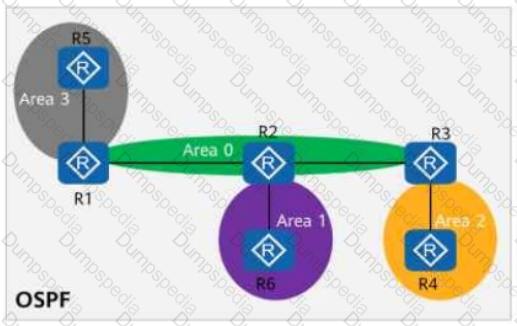
On the network shown in the figure, the DHCP server function is enabled on GEO/0/0 of R2, and the address pool is an interface address pool. When GEO/0/0 and GEO/0/1 of R1 function as DHCP clients, only one interface can obtain an IP address by default.

On the OSPFv3 network shown in the figure:
Area 1 is a stub area
Area 2 is a common area
Area 3 is an NSSA
The IPv6 address of Loopback0 on R6 is 2000::6/128.
The router ID of each router is 10.0.X.X, where X is the router number.
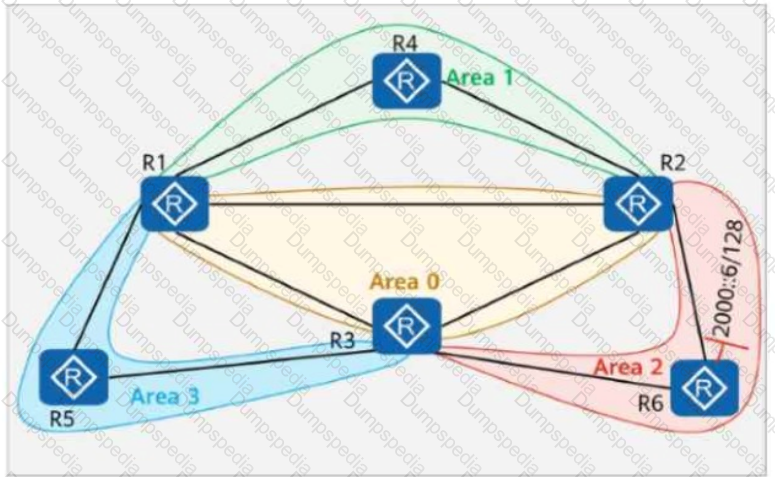
Which of the following statements are true?
An interface of a switch is in error-down state. A possible cause is that the average rate of broadcast packets received by the interface exceeds the upper threshold set by the administrator for storm control.
On the network shown in the figure, IS-IS runs on R1, R2, R4, and R5, and the area ID is 49.0001. IS-IS runs on R3 and R6, and the area ID is 49.0002. The import-route isis level-2 into level-1 command is configured on R2 and R5. In AS 65000, R1, R3, R4, and R6 each establish iBGP peer relationships with R2 and R5. R2 and R5 are RR (Route Reflectors), and R1, R4, R3, and R6 are the iBGP peer relationship clients. The iBGP peer relationship ID is 10.0.0.X/32, where X is the number of the iBGP router. R1 and R4 import the external route 192.168.1.0/24 to BGP through the import-route command, and R3 and R6 import the external route 192.168.2.0/24 to BGP through the import-route command. Which of the following statements are true?
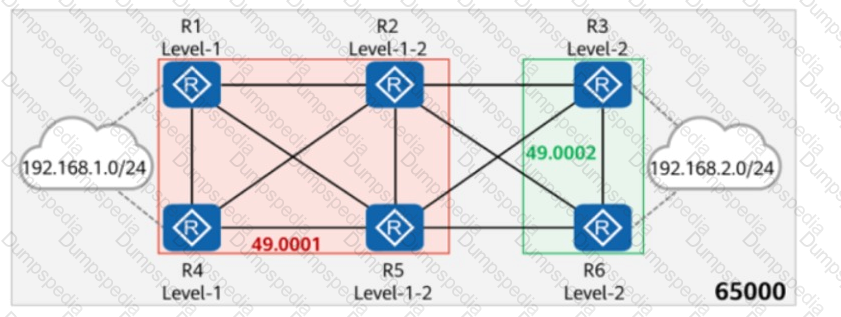
On the OSPF network shown in the figure, the cost values of links are marked. OSPF IP FRR is enabled on R1. The primary path from R1 to 10.0.3.3/32 is R1 -> R2 -> R3, and the backup path is R1 -> R4 -> R2 -> R3.
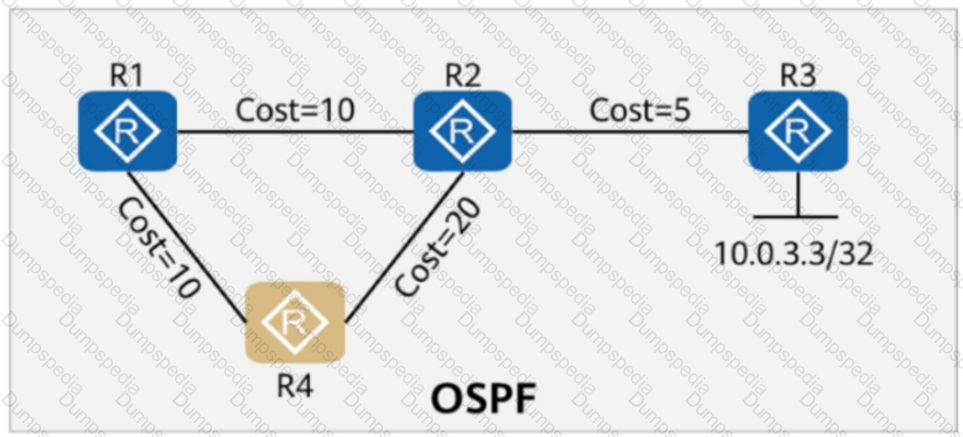
On the network shown in the figure, IS-IS runs on R1, R2, R4, and R5, and the area ID is 49.0001. IS-IS runs on R3 and R6, and the area ID is 49.0002. The import-route isis level-2 into level-1 command is configured on R2 and R5. In AS 65000, R1, R3, R4, and R6 each establish IBGP peer relationships with R2 and R5. R2 and R5 are RRs, and R1, R4, R3, and R6 are clients. The IBGP peer relationships are established using Loopback0. The IP address of Loopback0 on each router is 10.0.X.X/32, and the router ID is 10.0.X.X, where X is the number of the router. R1 and R4 import the external route 192.168.1.0/24 to BGP through the import-route command, and R3 and R6 import the external route 192.168.2.0/24 to BGP through the import-route command. Which of the following statements are true?
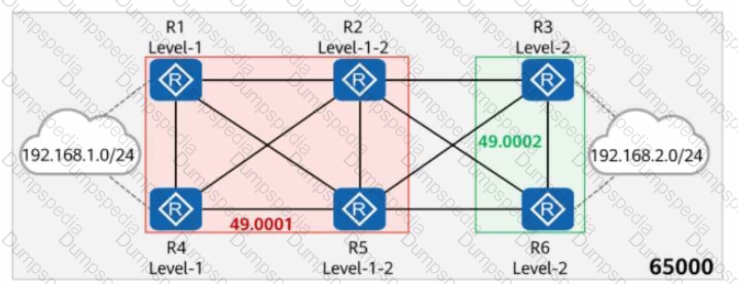
On the network shown in the figure, IS-IS runs on Rl, R2, R4, and R5, and the area ID is 49.0001. IS-IS runs on R3 and R6, and the area ID is 49.0002. In AS 65000, Ri, R3, R4, and R6 each establish IBGP peer relationships with R2 and R5. R2 and R5 are RRs, and Rl, R4, R3, and R6 are clients. The IBGP peer relationships are established using LoopbackO. The IP address of LoopbackO on each router is 10.0.X.X/32, and the router ID is 10.0.X.X, where X is the number of the router. Rl and R4 import the external route 192.168.1.0/24 to BGP through the import-route command, and R3 and R6 import the external route 192.168.2.0/24 to BGP through the import-route command. Which of the following statements are true?

On the network shown in the figure, EBGP peer relationships are established between neighboring routers through directly connected interfaces.
The router ID of each router is 10.0.X.X, and the AS number is 6500X, where X is the number of the router.
Both R1 and R4 have static routes to 192.168.1.0/24, which are imported to BGP through the import-route command.
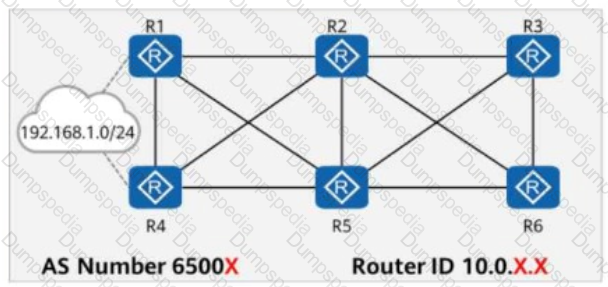
Which of the following statements are true?
VLAN aggregation is configured on a switched network. Sub-VLAN 2 and Sub-VLAN 3 are added to Super-VLAN 10. To enable hosts in different sub-VLANs to communicate with each other, run the following command in the VLANIF 10 view corresponding to the Super-VLAN.
(Enter lowercase letters.)
On the OSPFv3 network shown in the figure:
OSPFv3 is enabled on the interfaces connecting R1, R2, and R3.
The router ID of each router is 10.0.X.X, where X is the number of the router.
If you check detailed information about an LSA on R3, the command output shows that the LSA is generated by R2 and describes the IPv6 prefix address associated with the Router-LSA.

Is this statement TRUE or FALSE?
On the OSPFv3 network shown in the figure, OSPFv3 is enabled on the interfaces connecting R1, R2, and R3. The router ID of each router is 10.0.X.X, where X is the number of the router. If you check detailed information about an LSA on R3, the command output shows that the LSA is generated by R2 and describes the IPv6 prefix address associated with the Router-LSA.

On the network shown in the figure, IS-IS IPv6 runs on R2, R6, and R3, and the IPv6 address of Loopback0 on R6 is 2000::6/128. OSPFv3 runs on other links. Area 1 is a stub area, and Area 2 is an NSSA. IS-IS routes are imported to OSPFv3 on R2 and R3. Which of the following statements are true?
